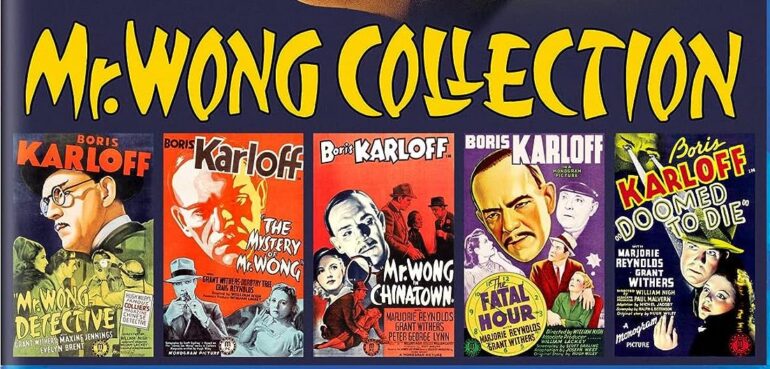Verdict
Summary
Karloff’s contributions to these five films is not quite iconic, but all of them are decent enough diversions for fans of black and white classic mysteries.
Mr. Wong, Detective (1938) Plot:
An inventor of a special chemical formula is accused of murder of the man who stole his formula.
Review:
Everyone wants the special formula that might have some use for the government … or the mob. It is a silent, invisible killer, and when the inventor makes a deal to sell it a to a big chemical company, the deal goes bad when the inventor realizes that he’s been had and won’t get paid for his work. The man who swindled the inventor hires a notorious detective named Wong (Boris Karloff in his first of five appearances as the character) to help him prove that he’s in the right, but by the time Wong shows up at his office the next morning for a meeting, the man has mysteriously died, most likely murdered, but the case perplexes the cops, who think the inventor killed him. Wong has another theory: a small bit of glass near the scene of the corpse points to the probability that the secret formula was in a small vial and was crushed, releasing the deadly chemical and killing the man. But who would kill him? The inventor? The mob? Or someone else? Wong will solve the case!
A 68 minute mystery that gives star Karloff a bit of room to flex his acting muscles aside from grunting as Frankenstein, Mr. Wong, Detective shows him as an armchair sleuth in the vein of Mr. Moto or Sherlock Holmes, always one quick step ahead of the too-eager police detectives who think they know it all, but are always befuddled by the clue that intrigues the true sleuth. Simplistic, but never boring, this feature should satisfy fans of old mysteries. From director William Nigh.
The Mystery of Mr. Wong (1939) Plot:
A gem has been hidden amidst a party gathering where the host ends up murdered.
Review:
A priceless jewel is smuggled from the Orient and ends up at a cocktail party at a swanky home where the hoi polloi end up boozing and schmoozing one evening. Famed armchair detective Mr. Wong (Boris Karloff) happens to have been an invited guest, where he happily enjoys watching an impromptu game of charades and a quickly rehearsed play are performed by some of the guests – and the host of the party as well. In the play, the host is shot with what’s supposed to be a prop gun with a blank, but the man never rises from the floor after the play, and it is determined that he was killed in an accident by the gun, which turned out to not have been a prop gun at all. Mr. Wong suspects that perhaps there was another gun that went off at precisely the same moment at the prop gun, and when the police arrive, the guests are all put on lockdown until they can get to the bottom of what might’ve been a murder. A note left by the host in the event of his violent death is given to Mr. Wong, and it is there when he realizes that the man predicted his own death, and it all leads to the fact that there was a jewel in the house and that someone was trying to procure it by any means necessary. Mr. Wong gathers all the suspects around a secure area and makes his deductions and then he finally points to the killer and their motive.
A simple “whodunnit” mystery in the style of so many pulpy mysteries, The Mystery of Mr. Wong is a worthy follow-up to Mr. Wong, Detective. While Karloff gets to deliver some calculating monologues, his co-stars have a good time acting befuddled, sinister, and all-knowing despite all their sins and motives. It’s decent fun if you’re up for a quick diversion at only 68 minutes. Competently directed by William Nigh.
Mr. Wong in Chinatown (1939) Plot:
Mr. Wong helps solve the murder of a Chinese princess.
Review:
A young woman staggers into Mr. Wong’s home, and she practically dies in his arms. Shocked, Mr. Wong (Boris Karloff) calls the police, who are stunned that Mr. Wong could potentially be a suspect in this woman’s murder. Of course, they give him the benefit of the doubt because he didn’t know the girl and had no motive for killing her, and so he assists in investigating whom the woman was and why and how she was killed. It turns out that the woman was a Chinese princess, very wealthy and living in Chinatown, and as Wong and the detectives (and a plucky and pretty investigative reporter looking for a scoop) discover that the woman had been making constant withdrawals from her bank account, Wong makes a visit to her bank and surmises that perhaps the woman’s identity had been stolen and someone had been forging checks under her name. It doesn’t take long for Mr. Wong to figure out who the killer is, and when he does, his life is in danger when he and the bank manager are kidnapped and shanghaied and put on a ship where their bodies will soon be dumped overboard in the ocean if they don’t escape soon!
A little more lenient on the plot than in the previous entries in the series, Mr. Wong in Chinatown sometimes moves without much scripting, and there are silly moments such as when Mr. Wong has to pantomime to a Chinese dwarf who can’t speak in order to communicate to him. The whole scene is ridiculous because Mr. Wong is Chinese and should be able to speak to him, but the movie doesn’t think of that. There are other goofy moments like that in the movie, but the film is still entertaining and gives Karloff a little more to work with when his sleuth character is put in danger more than once. From director William Nigh.
The Fatal Hour (1940) Plot:
Wong and a detective team up to solve the murder of another detective.
Review:
An undercover detective working the docks in San Francisco harbor is found floating dead in the water, and the news is broken to his best friend, Captain Bill Street (Grant Withers) who takes the news hard. James Wong (Boris Karloff) visits the precinct to pay his respects, and instead of just letting the Captain take the case alone, Wong joins him out of respect. The two of them soon find themselves in a world where smugglers are trying to stop them from finding the truth, and with little clues to lead them on a trail, Wong gets an idea about a remote controlled radio that might help point to a suspect.
By the time Wong figures out who the killer is, I was still trying to keep track of what was going on, and the movie ends so suddenly that I considered rewinding the last act to see if I’d missed anything. The Final Hour is a pretty good little mystery, but the conclusion is very perfunctory and abrupt. Karloff as Wong almost feels like a side character this time, with the police captain (who’s always yelling at everyone except Wong) taking center stage this time. Side character Roberta, the intrepid journalist trying to get a scoop makes a return appearance from the previous entry. Directed by William Nigh.
Doomed to Die (a.k.a. Mystery of the Wentworth Castle) (1940) Plot:
A ship sinks with all aboard, leading to the shocking murder of the man who owned the ship.
Review:
A ship and its crew sinks at sea, killing all aboard. The owner of the ship is absolved of all responsibility, but receives an insurance sum. His chief competitor offers to buy him out, and he refuses. Also, his competitor’s son is very intent on marrying his daughter – with or without his blessing. When the man is shot to death, the other man’s son is the clear and obvious suspect because they were just seen having an argument about the young man’s intention to marry his daughter. The young man is picked up by the police, and Mr. Wong (Boris Karloff) offers to help the police figure out who the killer is, and whether or not the suspect in custody is responsible.
The fifth and final Mr. Wong mystery, Doomed to Die has a good enough mystery at its center, and a centerpiece car chase that goes hard and heavy for a minute or two. Karloff’s contributions to these five films is not quite iconic, but all of them are decent enough diversions for fans of black and white classic mysteries. This one was directed by William Nigh.
Kino Lorber’s new two-disc Blu-ray collection of all five of these films comes with an audio commentary by two film historians on the first film.



